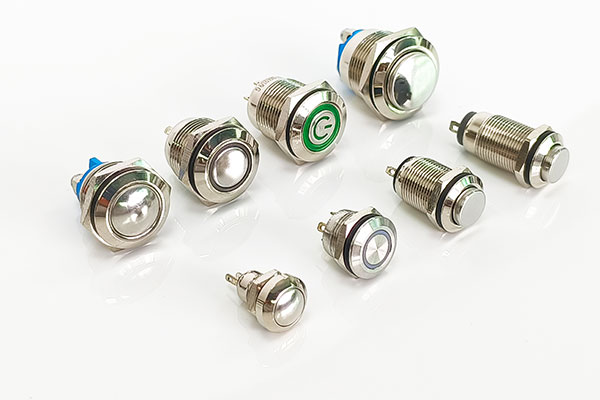Knowledge
Key Points for Purchasers to Know About Metal Push Button
Metal push buttons are a staple in modern design and industrial applications, known for their durability, functionality, and sleek appearance. However, selecting the right metal push button for a specific application can be complex due to the variety of options available. For purchasers, understanding key considerations can simplify the selection process and ensure the switch meets operational, aesthetic, and budgetary requirements. Below is a detailed guide highlighting the most important aspects purchasers need to know about metal push buttons.

1. Material and Build Quality
The material of the push button determines its durability, resistance to environmental factors, and aesthetic appeal. Common materials include:
Stainless Steel: Known for its high corrosion resistance, it is ideal for harsh environments or applications exposed to moisture, chemicals, or extreme weather.
Aluminum: Lightweight and corrosion-resistant, often used in applications where weight savings are crucial.
Brass: Frequently used for its decorative appeal, brass is suitable for indoor applications where aesthetics matter more than durability.
Plated Finishes: Some metal push buttons have chrome or nickel plating for enhanced appearance and additional corrosion resistance.
Purchasers should match the material to the environment and application to ensure longevity and reliability.
2. Environmental Protection Ratings
Metal push buttons often come with IP (Ingress Protection) ratings, which indicate their resistance to water and dust. Understanding these ratings is essential:
IP67: Provides complete dust protection and immersion resistance up to 1 meter for 30 minutes. Ideal for outdoor or industrial environments.
IP65: Resistant to dust and water jets, suitable for general-purpose use in moderately harsh conditions.
IP68: Ensures higher water resistance for prolonged immersion, often used in marine or high-humidity environments.
Selecting a switch with the appropriate IP rating is crucial to ensure performance in challenging conditions.
3. Switch Types: Momentary vs. Latching
Metal push buttons come in two main operation types:
Momentary: The button returns to its default position once released. These are common for applications like doorbells, vehicle horn switches, or starter circuits.
Latching: The button stays in its pressed state until pressed again. These are used in applications such as power toggles or mode selection.
Purchasers must understand the functional requirements of their application to choose the correct actuation mechanism.
4. Electrical Ratings
The electrical specifications of the push button, including current and voltage ratings, are critical for safety and compatibility. Metal push buttons are available with ratings such as:
Low-current switches for electronics and signal circuits (e.g., 5V DC, 0.5A).
High-current switches for industrial or power control systems (e.g., 250V AC, 16A).
Purchasers should ensure the chosen switch can handle the electrical load of the application without overheating or failing.
5. Size and Mounting Requirements
Metal push buttons come in various sizes, with standard diameters ranging from 16mm to 30mm or more. The appropriate size depends on:
Panel Space: Ensure the button fits within the available space without crowding other components.
Aesthetics: Larger buttons may be more visible and easier to operate, while smaller buttons create a sleeker look.
Mounting Type: Options include screw-thread mounting for secure attachment or snap-fit designs for quicker installation.
6. Illumination Options
Many metal push buttons feature integrated LEDs for illumination, which can enhance usability and aesthetics. Key illumination options include:
Ring or Dot Illumination: LEDs light up in specific patterns, such as around the button’s perimeter or as a central indicator.
Color Choices: Red, green, blue, white, and multicolor LEDs are available, enabling users to signal statuses like power, standby, or error states.
Voltage Compatibility: Ensure the LED is compatible with the device’s power supply (e.g., 12V, 24V, or 110V).
Purchasers should consider whether illumination adds value to the application in terms of visibility and feedback.
7. Tactile Feedback and User Experience
Metal push buttons are valued for their robust tactile feedback. Key aspects to evaluate include:
Actuation Force: The force required to press the button can vary; lighter presses suit frequent use, while firmer presses help avoid accidental activation.
Feedback Mechanism: Look for switches with a satisfying "click" or resistance that signals activation, ensuring user confidence.
8. Aesthetic Considerations
The visual design of metal push buttons can significantly impact the overall appearance of a product or system. Purchasers can choose from options like:
Finish: Polished, brushed, or anodized finishes for a specific look.
Shape: Round, square, or custom shapes to match design themes.
Custom Engraving: Many suppliers offer engraving services for symbols, logos, or text to indicate function or enhance branding.
9. Safety and Compliance
Purchasers should confirm that the metal push button complies with safety standards relevant to their industry. Certifications to look for include:
CE Marking: Indicates compliance with European safety, health, and environmental protection standards.
UL Certification: Ensures the product meets safety requirements for the U.S. and Canadian markets.
RoHS Compliance: Verifies the switch is free from hazardous substances.
10. Cost and Supplier Reliability
Finally, purchasers should balance cost with quality and reliability. While cheaper options may seem appealing, inferior materials or construction can lead to premature failure. It’s advisable to:
Research Suppliers: Choose reputable manufacturers with a track record of producing high-quality switches.
Request Samples: Evaluate the switch's build, tactile feel, and performance before placing bulk orders.
Check Warranties: A warranty indicates the manufacturer’s confidence in the product.
Conclusion
Purchasers of metal push buttons must consider a range of factors, including material, environmental resistance, operational type, electrical specifications, and design features. By carefully evaluating these aspects and selecting a reliable supplier, buyers can ensure they choose the best switch for their application, balancing functionality, durability, and aesthetics.
RELATED NEWS
- Types of Anti-Vandal Switches 2025-02-28
- Where Are Anti-Vandal Switches Used 2025-02-27
- The tact switch with integrated LED for illumination vision 2025-02-27
- Introduction to LED Tact Switches 2025-02-18
- An Article For Emergency Stop Push Button 2025-02-11
CATEGORIES
LATEST NEWS
CONTACT US
Contact: Bella
Phone: 15999819066
E-mail: rucoe@rucoe.com
Whatsapp:+86-15999819066
Add: Taoyuan Street, Nanshan, Shenzhen
